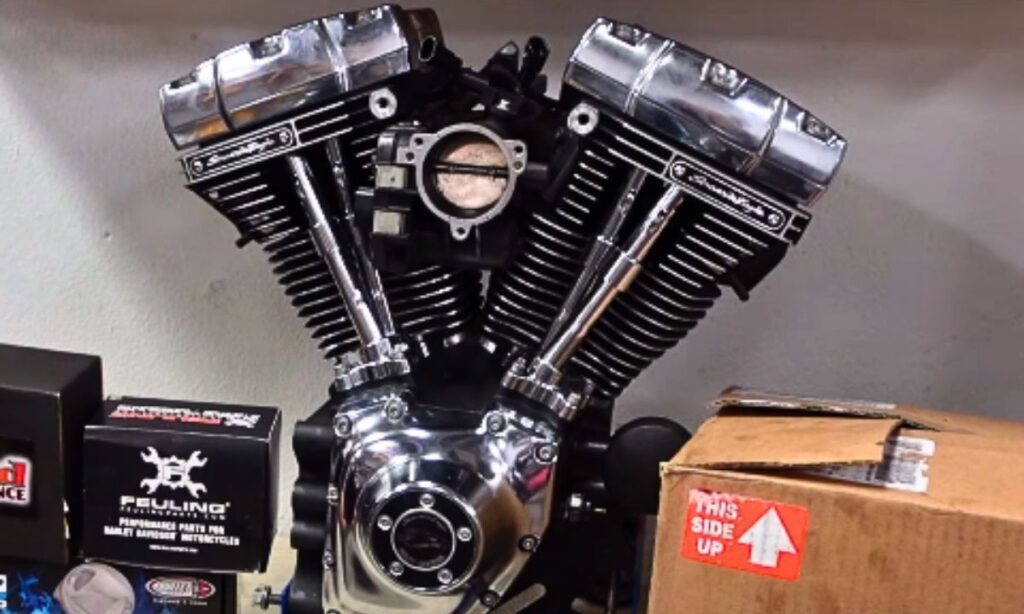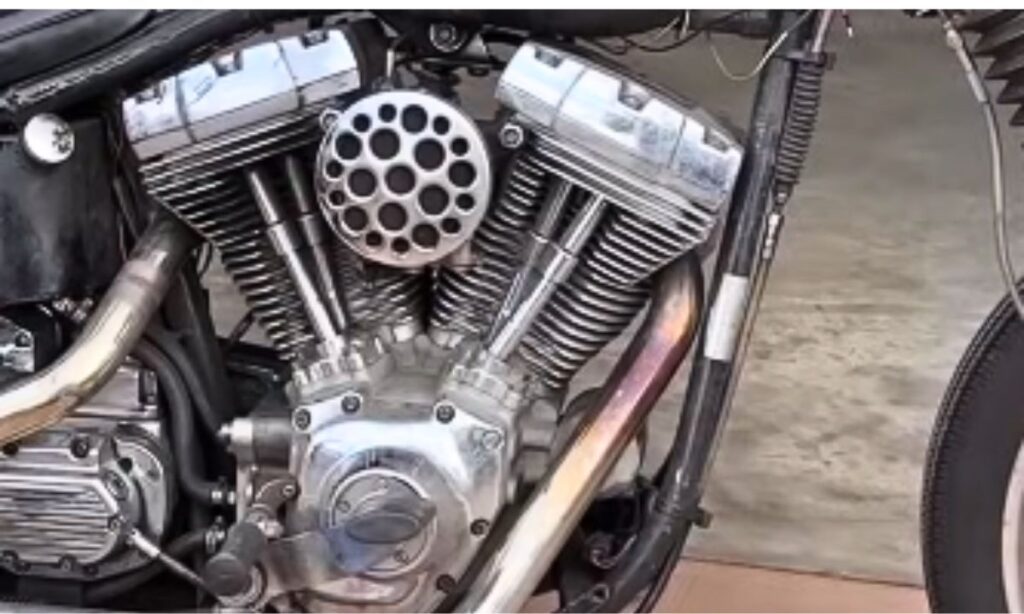When it comes to classic Harley-Davidson engines, the Panhead and Shovelhead are two names that are bound to come up.
Both engines, with their unique features and performance capabilities, left indelible marks on the motorcycle industry.
In this article, we will dive into the complete comparison between Panhead and Shovelhead.
Panhead Vs Shovelhead
The Panhead and Shovelhead are two iconic engine designs produced by the well-known motorcycle manufacturer Harley-Davidson.
The Panhead engine was introduced in 1948 and boasts aluminum cylinder heads and hydraulic lifters, a combination that offers enhanced cooling and reduced mechanical noise compared to its predecessor, the Knucklehead.
It was popular for its blend of power and reliability and quickly became synonymous with the Harley-Davidson brand.
On the other hand, the Shovelhead, launched in 1966, is known for its unique valve design, resembling the edge of a shovel, hence the name.
It came as an evolution to the Panhead, with an aim to increase power and improve oil circulation.
The Shovelhead was well-received due to its high torque and distinctive sound, solidifying its status in the Harley-Davidson lineage.
While both engines have their unique charms, the choice between Panhead and Shovelhead often boils down to personal preference.
Some riders appreciate the classic feel and reliability of the Panhead, while others prefer the robust power and unique design of the Shovelhead.
Regardless of the choice, both engines embody the spirit of Harley-Davidson’s rich history and commitment to performance.

Comparison Between Panhead and Shovelhead
The Harley-Davidson Panhead and Shovelhead engines are both iconic models renowned for their style and performance.
The Panhead, produced from 1948 to 1965, is known for its pan-shaped valve covers and provides a vintage riding experience.
It’s revered for its classic aesthetic appeal and smooth-running mechanics.
On the other hand, the Shovelhead, produced from 1966 to 1985, received its name from the shovel-shaped valve covers.
So here is the complete comparison between the Panhead and Shovelhead:
1. Engine Specifications
Panhead Engine Specifications
The Panhead, introduced by Harley Davidson in 1948, had an engine displacement of 61 cu in (1,000 cc) to 74 cu in (1,200 cc).
The model is characterized by its stamped steel rocker covers, which resemble cooking pans, lending to its unique name.
It’s renowned for its increased power and smooth operation due to its aluminum heads and hydraulic valve lifters.
Shovelhead Engine Specifications
The Shovelhead, succeeding the Panhead in 1966, boasted a similar displacement range, with models available from 74 cu in (1,200 cc) to 82 cu in (1,340 cc).
It gained its moniker from the shovel-like shape of its rocker covers. The Shovelhead offered improved oil circulation and cooling aspects, though it was initially plagued by some teething issues.
Over the years, design enhancements improved its performance and reliability, making it a beloved classic.
2. Strength
A key factor to consider when comparing the Panhead and Shovelhead engines from Harley-Davidson is their respective strengths.
The Panhead engine brought a significant improvement in power and cooling over its predecessor, the Knucklehead.
The Panhead engines were renowned for their reliability and smoother operation, which resulted from the inclusion of hydraulic valve lifters.
On the other hand, the Shovelhead was a direct evolution of the Panhead.
The Shovelhead’s main strength was its increased power output and capacity, courtesy of its reshaped combustion chamber, resembling a shovel, hence the name.
This engine offered a greater cubic inch displacement, leading to better overall performance.
3. Design & Appearance
The Panhead and Shovelhead are both iconic Harley-Davidson engines, each with their distinctive designs and appearances.
Panhead
The Panhead, produced from, is named for its pan-like rocker covers. These covers have a distinct, rounded shape, lending the engine its unique appearance.
The Panhead’s design is synonymous with the classic, vintage Harley-Davidson look.
The engine’s aesthetics offer a nostalgic nod to the post-war era of motorcycles, with its chrome covers adding a polished, stylish finish that is still greatly admired by enthusiasts.
Shovelhead
On the other hand, the Shovelhead earned its name due to the shovel-like shape of its rocker covers.
The covers’ design has a more squared-off look compared to the rounded Panhead.
This gives the Shovelhead a more robust and mechanical appearance, reflecting the evolution of motorcycle design in the 1960s and 1970s.
The Shovelhead’s design embraces a grittier industrial aesthetic, showcasing the engine’s internal workings with less emphasis on polished chrome finishes.
4. Bore & Stroke Design
Harley-Davidson’s Panhead and Shovelhead engines both have unique bore and stroke designs that distinguish them from one another.
The Panhead, produced between 1948 and 1965, features a 3.4375-inch bore and 3.5-inch stroke in its 74 cubic-inch variant.
This design allows for a displacement of 1208cc and is known for its impressive low-end torque and smoother operation.
On the other hand, the Shovelhead carries forward the bore and stroke dimensions from the Panhead in its early versions.
However, in 1978, the Harley-Davidson Super Glide engines were updated to a 3.8125-inch bore and 4.25-inch stroke, increasing the displacement to 1340cc.
This change elevated the power output, delivering greater top-end performance.
Yet, it’s important to note that this increase in power came at the cost of the engine running hotter and requiring more maintenance.
5. Carburetor Design
When comparing Panhead and Shovelhead engines, their carburetor designs significantly differentiate the two.
The Panhead engines were equipped with the Linkert carburetors. The simplistic and robust design of these carburetors made them reliable and relatively easy to maintain.
Their main highlight is the brass float, which provides precise fuel metering, ensuring optimal engine performance.
However, these carburetors are not adjustable and require manual adjustments to control the air and fuel mixture.
On the other hand, the Shovelhead engines switched to the Tillotson carburetors.
These carburetors were more intricate in design, featuring an adjustable idle mixture screw and an accelerator pump for better throttle response.
They allowed for more precision, offering riders the ability to adjust the carburetor to suit riding conditions and personal preferences, thereby enhancing performance and fuel efficiency.
6. Structure
The Panhead engine design was a significant improvement over its predecessor, the Knucklehead.
It featured aluminum cylinder heads, which helped to reduce weight and dissipate heat more efficiently.
The Panhead also introduced hydraulic valve lifters, which reduced the need for frequent valve adjustments and contributed to a smoother, quieter running engine.
The Shovelhead carried over the hydraulic lifters from the Panhead but redesigned the combustion chamber for increased power output.
This engine was particularly noted for its improved oil circulation system, which helped to extend the lifespan of the engine components.
7. Performance
When discussing the performance aspects of Panhead and Shovelhead engines, it’s crucial to consider factors such as power output, reliability, and fuel efficiency.
The Panhead engine is renowned for its distinct design, and while it may not match today’s engines’ power, it was a significant step up from its predecessor.
The Panhead typically outputs between 55 and 60 horsepower, with a displacement of 1200cc or 74 cubic inches.
It was lauded for its reliability and smoother operation, owing to improvements in the hydraulic valve lifters.
On the other hand, the Shovelhead is a high-performance upgrade over its predecessor, the Panhead.
With a horsepower ranging between 60 to 70 and a larger displacement of up to 1340cc or 82 cubic inches, it offered greater power and speed.
It featured an improved oil pump and a newly designed combustion chamber, leading to better cooling and fuel efficiency.
8. Features and Innovations
The Panhead and Shovelhead are iconic engines by Harley, each showcasing distinct features and innovations.
The Panhead engine key features aluminum heads and hydraulic valve lifters for reduced noise and improved reliability, along with better oil circulation.
The introduction of these features resulted in an engine that was easier to maintain and more user-friendly.
On the other hand, the Shovelhead engine featured a 10% increase in power due to the modified combustion chamber and increased displacement.
Innovative features like the self-adjusting timing chain and hydraulic lifters made it more durable.
Furthermore, it introduced electric start in Harley-Davidson motorcycles, making them more accessible to a broader audience.
Advantages and Disadvantages of Panhead and Shovelhead
Each engine type has its unique advantages and drawbacks, influencing performance, maintenance needs, and overall ride experience.
Here are the detailed pros and cons of these two engine types.
Pros of Shovelhead
The Shovelhead, a classic Harley-Davidson engine model, boasts several significant advantages.
Firstly, its iconic design with an easily recognizable shovel-shaped cover enhances the overall aesthetic of any motorcycle.
Secondly, it offers a power upgrade compared to its predecessor, the Panhead.
This enhanced power output results in faster acceleration, making it ideal if you’re seeking a bit more performance.
However, Shovelheads have relatively straightforward mechanisms, making them easier to work on and repair.
They are also adaptable to various modifications, providing a level of customization that allows you to tweak your bikes for personal preferences or performance enhancements.
Due to their long production run, finding parts for Shovelhead engines is generally easy, making maintenance and restoration projects more accessible.
Cons of Shovelhead
Despite its iconic status, the Shovelhead does face some criticism. One of the major drawbacks of the Shovelhead is its reliability.
It was introduced at a time when manufacturing tolerances were not as tight as they are today; it often requires more maintenance and care.
Its design, although aesthetically pleasing, has been known to lead to oil leaks if not meticulously maintained, resulting in oil slick.
Another issue is the increased vibration at high RPMs, which can lead to increased wear and tear and, consequently, frequent part replacements.
This high-vibration environment can also lead to a less comfortable ride over long distances.
The Shovelhead, with its older technology, does not provide the same level of performance and fuel efficiency as some of its modern counterparts.
In terms of parts, while Shovelhead parts can still be found, they are becoming increasingly rare and expensive.
This can make maintenance and repairs costly and time-consuming, as sourcing the right components may pose a challenge.
Pros of Panhead
The Panhead engine possesses several notable advantages that contribute to its enduring popularity among motorcycle enthusiasts.
Firstly, its efficient design with aluminum heads allows for better cooling, leading to enhanced engine performance and longevity.
Secondly, the distinctive shape of its rocker covers, which resemble an upside-down pan, not only grants the engine its unique name but also adds a vintage aesthetic appeal.
Moreover, the Panhead is renowned for its robust and reliable nature, capable of withstanding long journeys with minimal maintenance.
Lastly, the engine’s simple construction makes it an ideal choice if you’re interested in customizing or rebuilding your motorcycles.
Cons of Panhead
Despite its popularity among vintage motorcycle enthusiasts, the Panhead engine does have some drawbacks.
Firstly, due to its age, parts for the Panhead can be scarce and expensive, making maintenance and repair a challenge.
However, the Panhead, with its heavy cast iron heads, can be quite weighty, potentially affecting the bike’s maneuverability.
It also tends to run hotter than more modern designs, partly due to the lack of an oil filter in original models, which can lead to more frequent oil changes and potential engine wear.
Moreover, the Panhead’s charging system is not as reliable as modern ones, which can lead to electrical troubles.
The Panhead’s old-fashioned push rod tubes can leak, leading to messy oil spills, and the engine’s overall vibration can make it an uncomfortable ride over long distances.

Tonmoy, the brains behind the influential motorcycle-focused website, TwoWheller.com, is a dedicated and passionate advocate for biking culture. Born and raised in a family of motorcycle enthusiasts, his love for two-wheeled transportation was ignited at an early age. His commitment to providing in-depth reviews and helpful tips for riders has established him as a respected figure in the motorcycle community.

